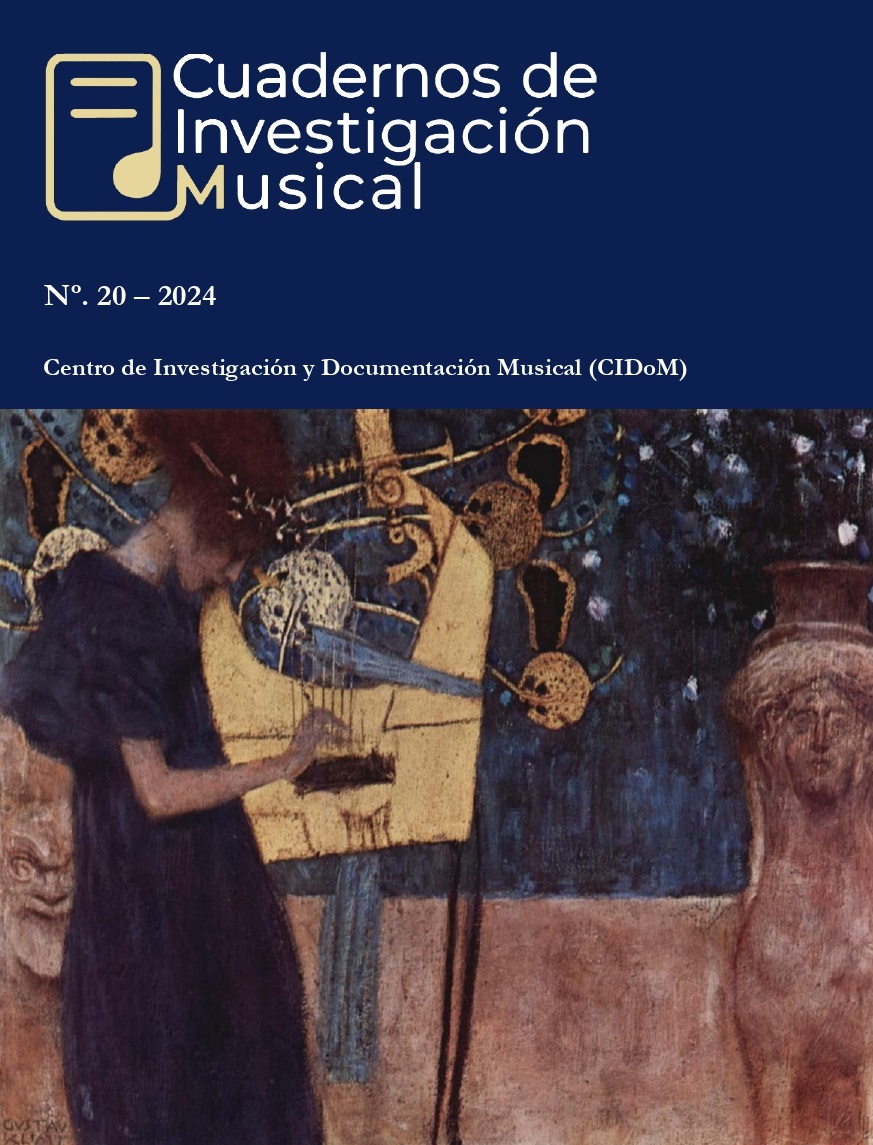Variations Op. 27/ii by Anton Webern. New analytical interpretation.
Main Article Content
Abstract
Anton Webern's conceptual foundations with respect to atonality appear ethereal and inaccessible; atonal practice was for him the manifestation of a Naturprozess towards which he felt impelled. Nevertheless, this article examines the appearance and persistence of non-tonal foundations, both in the intermediate and deeper layers of Variations Op. 27/ii; the existence of a neutralized sound space and the use of an interpolation pattern define the character of a micro-piece conceived as a tombeau for the death of Alban Berg.
Article Details

This work is licensed under a Creative Commons Attribution-NonCommercial-NoDerivatives 4.0 International License.
Los autores de los artículos mantienen el copyright, no recibirán ninguna contraprestación económica por el trabajo y el mismo siempre será reconocido como exclusivamente suyo. La revista se compromete a proteger la integridad y originalidad del artículo, así como los derechos de autor que correspondan. Los autores son los únicos responsables del material, textos e imágenes que utilizan en sus respectivos trabajos, debiendo respetar siempre los derechos de autor de terceras personas, por lo que la revista no se hace responsable de lo contenido en este tema respecto al trabajo de los autores.
References
Adorno, Th. W. (1959). Anton von Webern. Klangfiguren, Musikalische Schriften, I (pp. 157-181). Frankfurt: Suhrkamp.
Ansermet, E. (1989). Les fondements de la musique dans la conscience humaine et autres écrits. París: Robert Laffont.
Bailey, K. (2006). The Twelve-Note Music of Anton Webern: Old Forms in a New Language. Cambridge: Cambridge University Press.
Bass, R. (1994). Models of Octatonic and Whole-Tone Interaction: George Crumb and His Predecessors. Journal of Music Theory, 38 (2), pp. 155-186.
Brinkman, A. R. (1978). Johann Sebastian Bach's Orgelbüchlein: a computer-assisted study of the melodic influence of the cantus firmus on the contrapuntal voices. (Tesis doctoral). Chicago: University of Rochester.
Brinkman, A. R. (1990). PASCAL Programming for Music Research. Chicago: University of Chicago Press.
Chew, E. (2009). Pitch Symmetry and Invariants in Webern’s Sehr Schnell from Variations Op. 27, Communications in Computer and Information Science, 37, pp. 240-246.
Cook, N. (2009). Changing the musical object: approaches to performance analysis. En Z. Blazekovic (Ed.). Music's Intellectual History: Founders, Followers and Fads (pp. 775-790). New York: RILM.
Day, T. (2000). A Century of Recorded Music: Listening to Musical History. London. Yale University Press.
Forte, A. (1990). A Major Webern Revision and Its Implications for Analysis. Perspectives of New Music, 28(1), pp. 224-239.
Forte, A. (1996). The golden thread: octatonic music in Anton Webern’s early songs, with certain historical reflection. En K. Bailey (Ed.). Webern Studies (pp. 74-110), Cambridge: Cambridge University Press.
Jones, J. R. (1968). Some Aspects of Rhythm and Meter in Webern’s Opus 27. Perspectives of New Music, 7(1), pp. 103-109.
Katz, B. (1995). Harmonic Resolution, Neural Resonance, and Positive Affect. Music Perception, 13(1), pp. 79-108.
Koivisto, T. (1997). The Defining Moment: The Thema as Relational Nexus in Webern’s op. 27. Theory Only, 13, pp. 29-69.
Leibowitz, R. (1949). Introduction à la musique de douze sons. París: L’Arche.
Leleu, J. L. (1998). Intuition et esprit de système. Réflexions sur le schéma formel du deuxième mouvement des Variations pour piano op. 27 de Webern. Revue belge de Musicologie, 52, pp. 101-122.
Lerdahl, F. (1996). Calculating Tonal Tension. Music Perception, 13(3), pp. 319-363.
Lester, J. (1982). Harmony in Tonal Music Volume II: Chromatic Practices. New York: Alfred A. Knopf, Inc.
Lester, J. (1989). Analytic Approaches to Twentieth Century Music. New York: W.W. Norton & Company.
Lind, S. & Roeder, J. (2009). Transformational Distance and Form in Berg’s Schlafend trägt man mich. Music Theory Online, 15(1), pp. 1-8. https://doi:10.30535/mto.15.1.6
McKenzie, W.Ch. (1960). The Music of Anton Webern [Dissertation Abstracts, 21 (3), 640]. Washington: Library of Congress.
Mead, A. (1993). Webern, Tradition, and “Composing with Twelve Tones …” Music Theory Spectrum, 15(2), pp. 173–204. https://doi.org/10.2307/745813
Moldenhauer, H. (1971). Weberns letzte Gedanken. Melos, Zeitschrift für Neue Musik, 7/8, pp. 273-280.
Nelson, R.U. (1969). Webern’s Path to the Serial Variation. Perspectives of New Music, 7(2), pp. 73-92.
Nolan, C. (1995). Structural Levels and Twelve-Tone Music: A Revisionist Analysis of the Second Movement of Webern’s ‘Piano Variations’ Op. 27. Journal of Music Theory, 39(1), pp. 47-76.
Ogdons, W. (1962). A Webern Analysis. Journal of Music Theory, 6(1), pp. 133-138.
Post, W.D. (2014) Temporal Proportions as a Unifying Process in Anton Webern’s Variations for Piano Op. 27. International Journal of Humanities and Social Science, 4(7/1), pp. 1-11.
Riemann, H. (1890). Katechismus der Harmonielehre. Leipzig: Max Hesses Werlag.
Searle, H. (1967). El contrapunto del siglo XX. Barcelona: Vergara.
Shreffler, A. C. (1994). Mein weg geht Jetzt vorber: The vocal origins of Webern’s Twelve-tone Composition. American Musicological Society, Journal 47(2), pp. 275-307.
Straus, J. N. (2005). Introduction to Post-Tonal Theory. Upper Saddle River, NJ: Pearson Prentice Hall.
Syroyid Siroyid, B. (2020). Analysis of Silences in Music: Theoretical Perspectives, Analytical Examples from Twentieth Century Music, and In-Depth Case Study of Webern’s Op. 27/iii. (Tesis doctoral). Leuven: KU Leuven.
Travis, R. (1966). Directed Motion in Schoenberg and Webern. Perspectives of New Music 4(2), pp. 85-89.
Westergaard, P. (1963). Webern and Total Organization: An analysis of the Second Mouvement of the Piano Variations, Op. 27. Perspectives of New Music 1(2), pp. 103-120.
